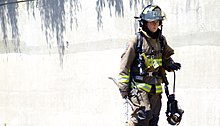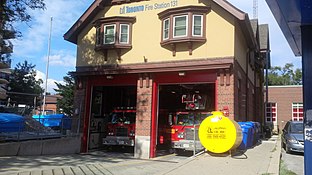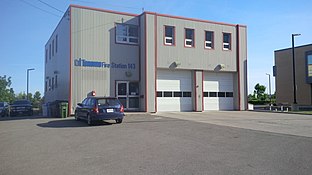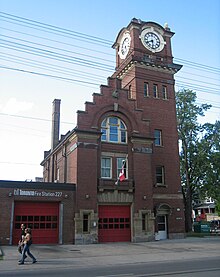
A fire engine is a vehicle, usually a specially-designed or modified truck, that functions as a firefighting apparatus. The primary purposes of a fire engine include transporting firefighters and water to an incident as well as carrying equipment for firefighting operations in a fire drill. Some fire engines have specialized functions, such as wildfire suppression and aircraft rescue and firefighting, and may also carry equipment for technical rescue.

The Los Angeles Fire Department provides firefighting services as well as technical rescue services, hazardous materials services and emergency medical services to the citizens of the city of Los Angeles, California, United States. The LAFD is responsible for approximately four million people who live in the agency's 471 square miles (1,220 km2) jurisdiction. The Los Angeles Fire Department was founded in 1886 and is the third largest municipal fire department in the United States, after the New York City Fire Department and the Chicago Fire Department. The department is sometimes also referred to as the Los Angeles City Fire Department or "LA City Fire" to distinguish it from the Los Angeles County Fire Department, which serves unincorporated areas and, via contracts, other incorporated municipalities within Los Angeles County without their own fire departments. The department is currently under the command of Chief Kristin Crowley.

The New York City Fire Department, officially the Fire Department of the City of New York (FDNY) is the full-service fire department of New York City, serving all five boroughs. The FDNY is responsible for fire suppression and fire prevention, and is a major provider of EMS services in New York City. Beyond fire suppression and EMS, the FDNY is responsible for a broad range of services, including technical rescue, CBRN defense, and structural collapse response and analysis. The FDNY is equipped with a wide variety of general-purpose and specialized Vehicles,Tools and Equipment to serve its varied missions.

A water tender, sometimes known as a water tanker, is a type of firefighting apparatus that specializes in the transport of water from a water source to a fire scene. Water tenders are capable of drafting water from a stream, lake or hydrant.
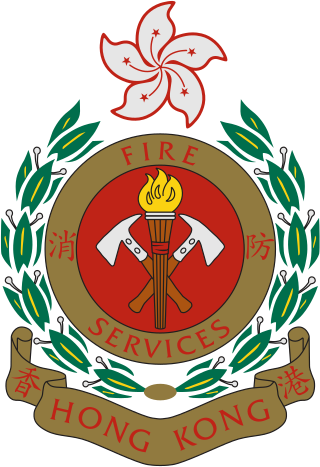
The Hong Kong Fire Services Department is an emergency service responsible for firefighting and rescue on land and sea. It also provides an emergency ambulance service for the sick and the injured and gives fire protection advice to the public. It is under the Secretary for Security who heads the Security Bureau.

Mississauga Fire and Emergency Services (MFES) provides fire protection, technical rescue services, hazardous materials response, and first responder emergency medical assistance to the city of Mississauga, Ontario, Canada.

A rescue vehicle is a specialised vehicle designed to transport and provide the equipment necessary for technical rescue. Vehicles carry an array of special equipment such as the jaws of life, wooden cribbing, generators, winches, hi-lift jacks, cranes, cutting torches, circular saws and other forms of heavy equipment unavailable on standard trucks. This capability differentiates them from traditional pumper trucks or ladder trucks designed primarily to carry firefighters and their entry gear as well as on-board water tanks, hoses and equipment for fire extinguishing and light rescue. Most rescue vehicles lack on-board water tanks and pumping gear, owing to their specialized role. A rescue vehicle is typically operated by a rescue squad, but in some areas it may be integrated with emergency medical services or fire departments.
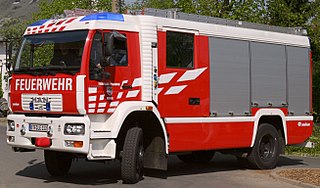
The Feuerwehr is a number of German fire departments. The responsible bodies for operating and equipping fire departments are the German communities ("Gemeinden") and cities ("Städte"). By law, they are required to operate fire-fighting forces. In cities, this is usually performed by the Fire Prevention Bureau, one of the higher-ranking authorities.
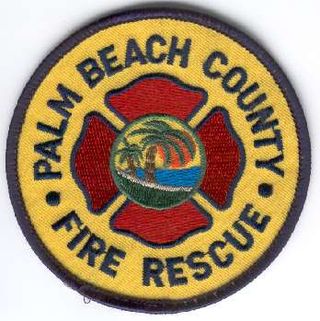
Palm Beach County Fire Rescue is one of the largest fire departments in the state of Florida. With 51 stations, Palm Beach County Fire Rescue provides fire protection, Advanced Life Support, emergency medical services, technical rescue, hazardous materials' mitigation, aircraft rescue/firefighting, fire investigation, and 911 dispatching for unincorporated parts of Palm Beach County, Florida as well as 19 cities under contract.
Fire services in the York Region of Canada are provided for and by each municipality. There are 35 fire stations across the region. Most services consist of full-time members, but some services have volunteer firefighters.
The San Diego Fire-Rescue Department (SDFD) is an all-risk, all-hazards fire department, providing fire protection and emergency medical services to the city of San Diego, California, United States. The San Diego Fire-Rescue Department is the second-largest municipal fire department in the state of California, after Los Angeles and responds to nearly 162,000 calls per year. The San Diego Fire-Rescue Department covers 343 square miles of service area including 17 miles of coastline, with responsibility extending 3 miles offshore.

The Israel Fire and Rescue Services is the national Israeli fire and rescue organization. The organisation also provides rescue services from terror attacks, car accident and dangerous substance spillages, along with Magen David Adom, the National EMS. They are also involved in public education and awareness campaigns. The service is accessed by calling 102 from any phone. As of 2022, the commissioner of the services is Eyal Casspi.
The Ventura County Fire Department (VCFD) provides fire protection and emergency response services for the unincorporated areas of Ventura County, California, and for seven other cities within the county. Together, these areas compose the Ventura County Fire Protection District in the state of California, USA. The Ventura County Board of Supervisors is the fire district's board of directors. These five elected supervisors appoint the fire chief, and task him with providing fire protection services for the district.

The Boston Fire Department provides fire services and first responder emergency medical services to the city of Boston, Massachusetts. It also responds to such incidents as motor vehicle accidents, hazardous material spills, utility mishaps, floods, explosions, and construction accidents among others.

Fire services in the United Kingdom use a variety of fire appliances, which perform a wide range of general and specialised roles and fit into several distinct categories. Contemporary fire appliances carry a multitude of equipment and firefighting media to deal with different types of emergencies ranging from fires, rescues, vehicle extrication, floods, salvage, casualty and trauma care.

Firefighting in the United States dates back to the earliest European colonies in the Americas. Early firefighters were simply community members who would respond to neighborhood fires with buckets. The first dedicated volunteer fire brigade was established in 1736 in Philadelphia. These volunteer companies were often paid by insurance companies in return for protecting their clients.
The New Haven Fire Department (NHFD) provides fire protection and emergency medical services to the city of New Haven, Connecticut. The New Haven Fire Department currently serves a population of over 130,000 people living in 19 square miles of land and is one of the largest fire departments in the state.

The Baltimore City Fire Department (BCFD) provides fire protection and emergency medical services to the city of Baltimore, Maryland, United States. Founded in 1797 and established in 1859, the Baltimore City Fire Department covers an area of 81 square miles (210 km2) of land and 11 square miles (28 km2) of water, with a resident population of over 640,000 and a daytime population of over 1,000,000. The BCFD responds to approximately 235,000 emergency calls annually. There are two International Association of Fire Fighters (IAFF) locals; IAFF 734 for firefighters and IAFF 964 for officers.
The Yonkers Fire Department (YFD) provides fire protection and emergency medical services to the city of Yonkers, New York, United States.

The Vancouver Fire Department (VFD) provides fire protection and emergency medical services to the city of Vancouver and, by contract to Clark County Fire District 5, in Washington, United States. The VFD's response area is 91 square miles (240 km2) with a population of over 294,000 (2023). The VFD has the highest call volume per firefighter in the state. ALS transport is provided by AMR, making the VFD's service area population by far the largest in Western Washington without public ALS ambulance service.











